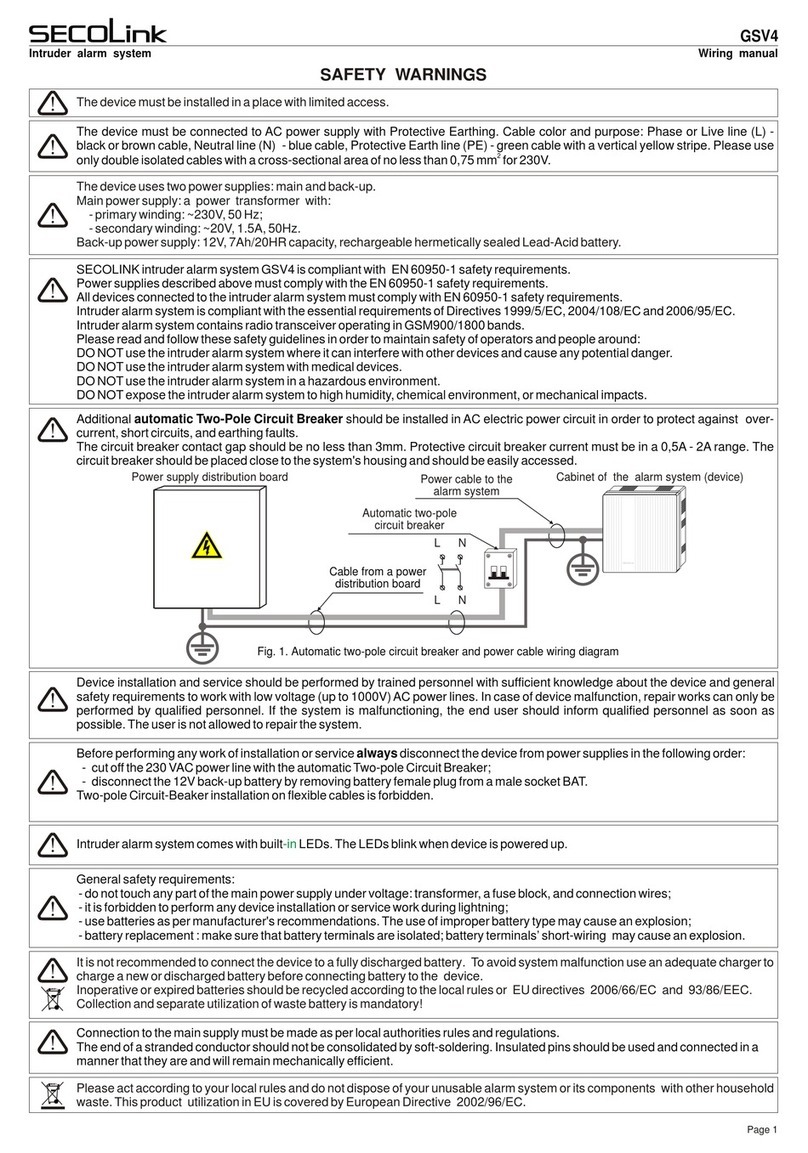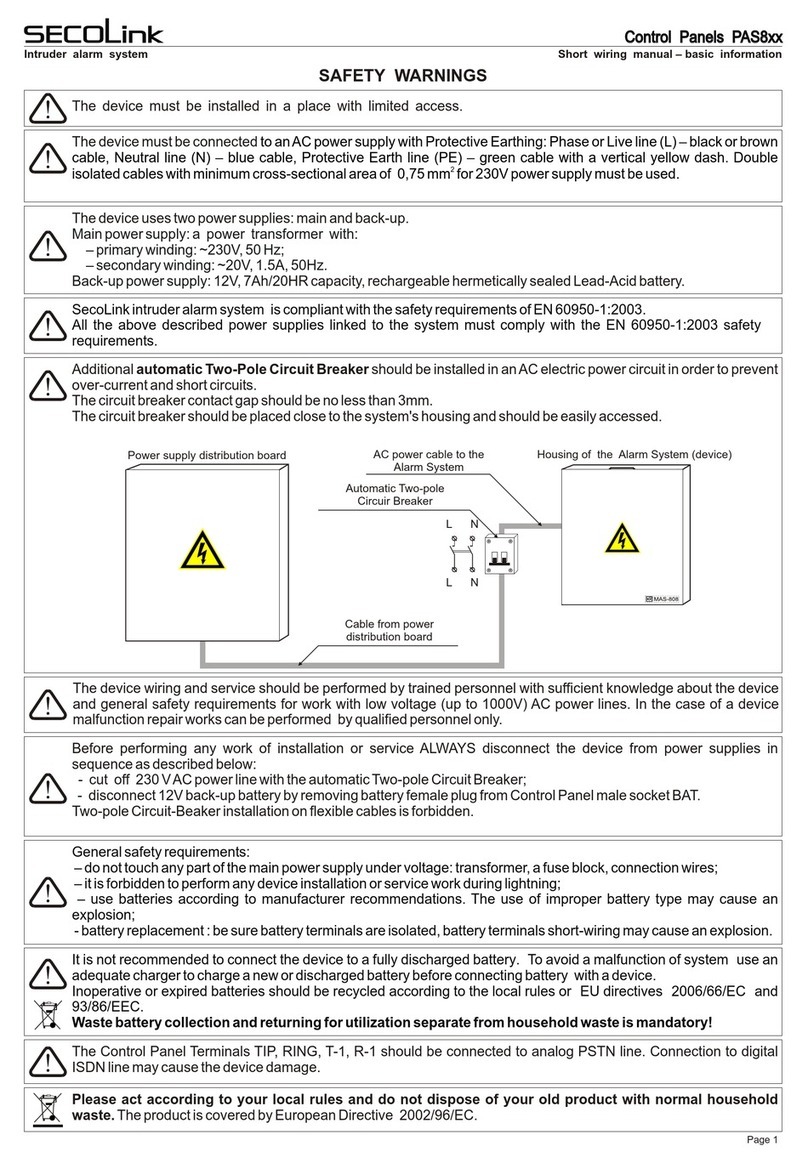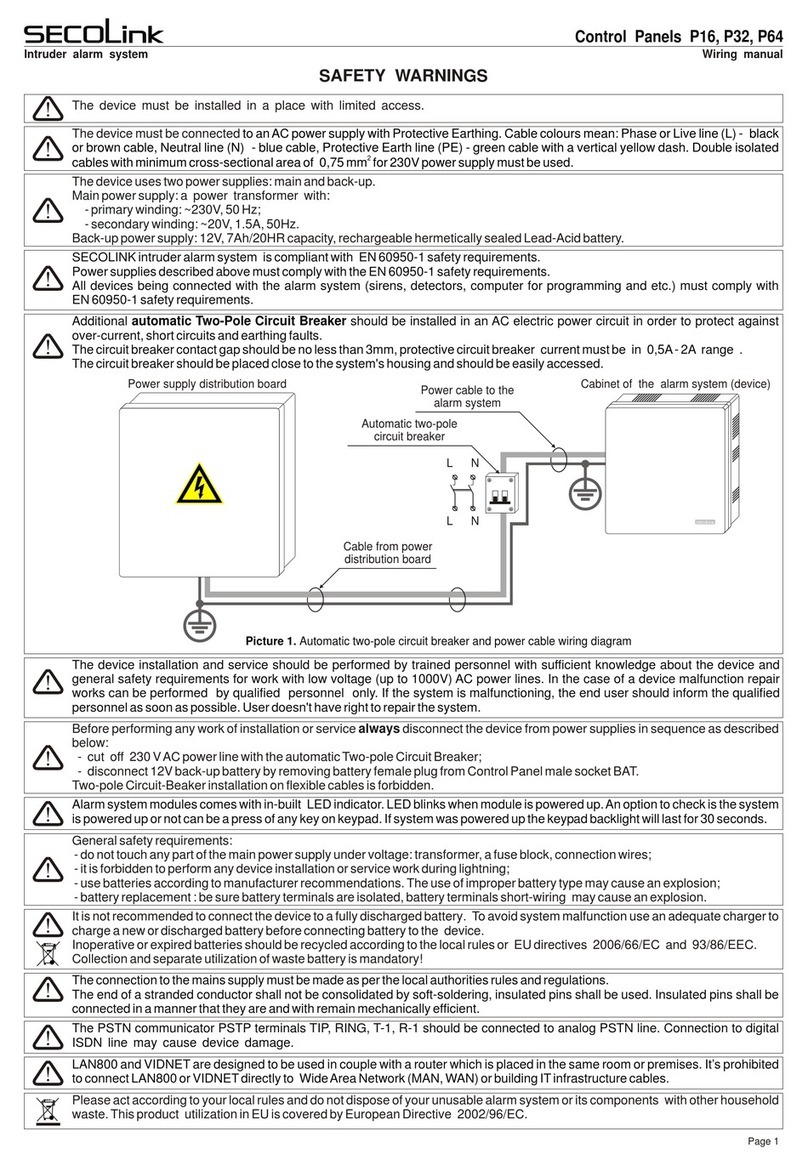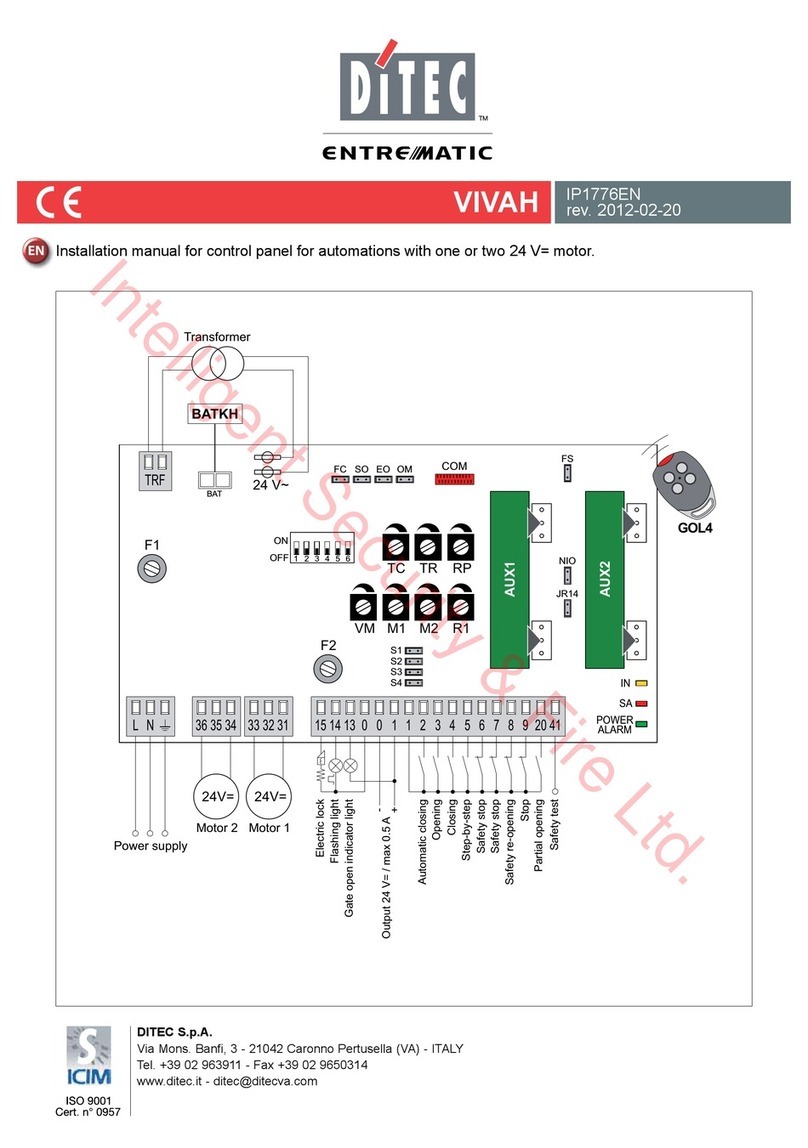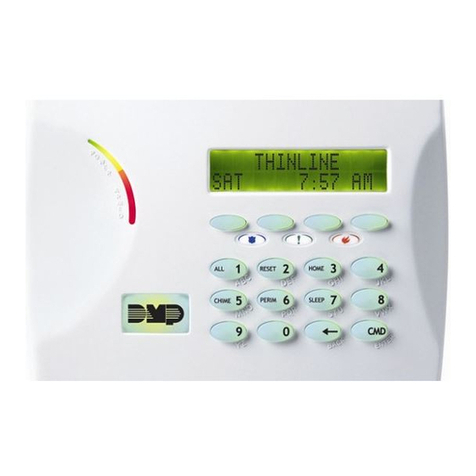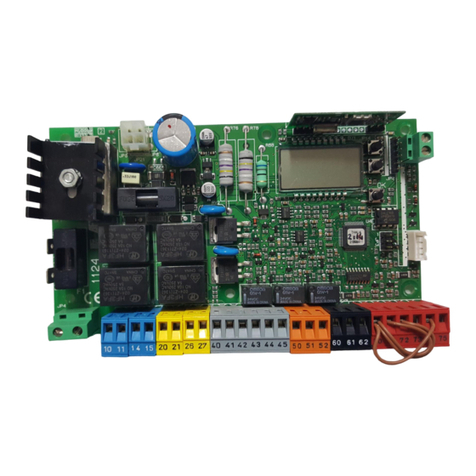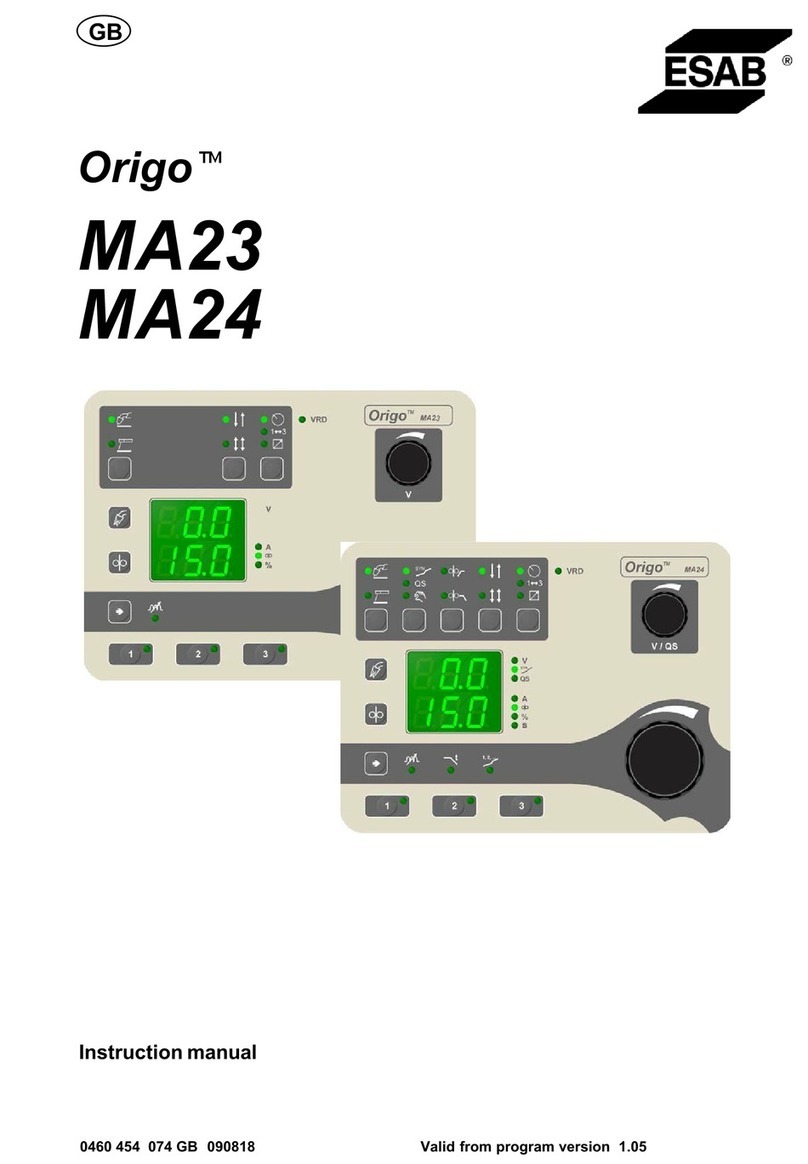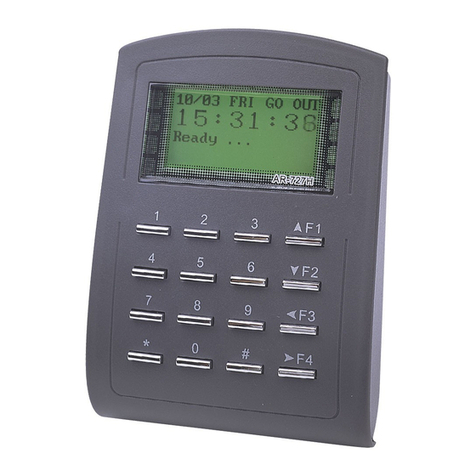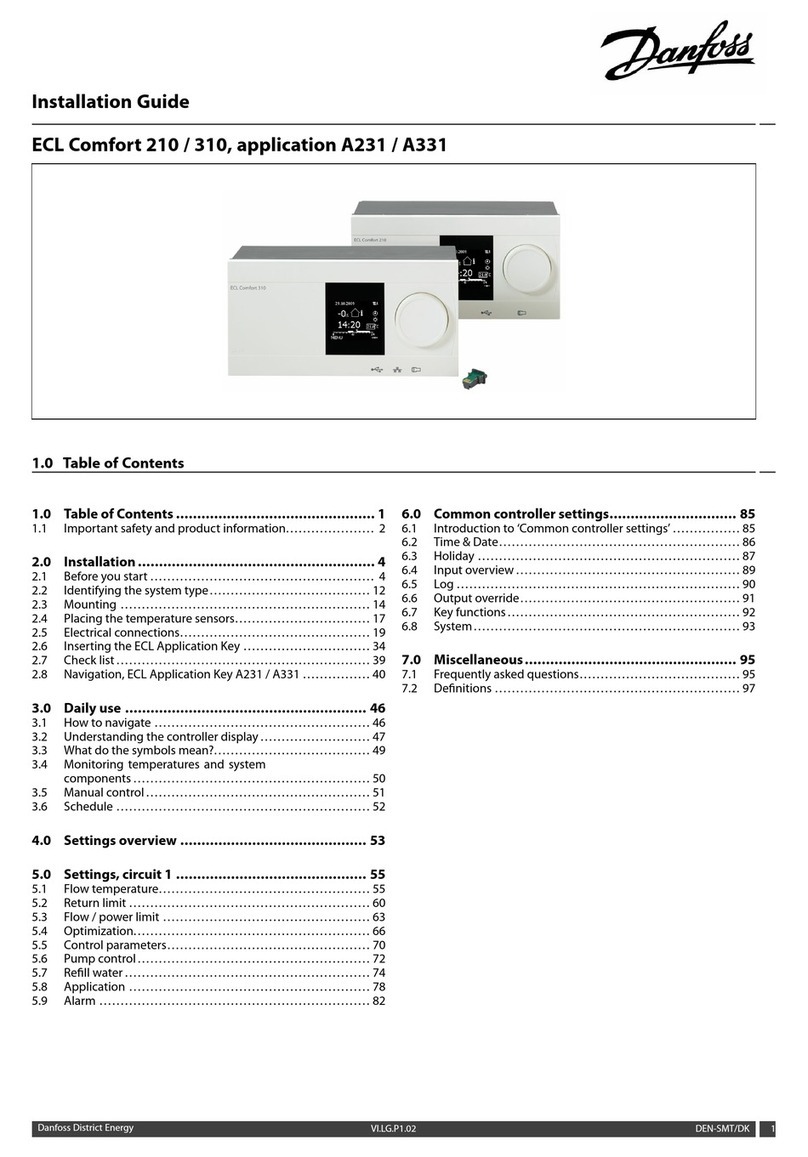SECOLink GSV4M User manual

GSV4M
Universal GSM / GPRS communicator Wiring manual
1
The device must be installed in a place with limited access.
Please act according to your local rules and do not dispose of your unusable alarm system or its components with other household
waste. This product utilization in EU is covered by European Directive 2002/96/EC.
The device must be connected to an AC power supply with Protective Earthing. Cable colours mean: Phase or Live line (L) - black
or brown cable, Neutral line (N) - blue cable, Protective Earth line (PE) - green cable with a vertical yellow dash. Double isolated
2
cables with minimum cross-sectional area of 0,75 mm for 230V power supply must be used.
The device uses two power supplies: main and back-up.
2V, 7Ah/20HR capacity, rechargeable hermetically sealed Lead-Acid battery.
Main power supply: a power transformer with:
- primary winding: ~230V, 50 Hz;
- secondary winding: ~20V, 1.5A, 50Hz.
Back-up power supply: 1
GSV4M is compliant with EN 60950-1 safety requirements.
Power supplies described above must comply with the EN 60950-1 safety requirements.
All devices being connected with the alarm system (sirens, detectors, computer for programming and etc.) must comply with
EN 60950-1 safety requirements.
The communicator contains a radio transceiver operating within GSM900/1800 frequency ranges.
DO NOT USE the communicator where interferences can arise because of the influence with other devices and this may causethe
potential danger.
DO NOT USE the communicator close to medical devices.
DO NOT USE the alarm system device in a dangerous environment with the risk of fire and explosion.
Additional automatic Two-Pole Circuit Breaker should be installed in an AC electric power circuit in order to protect against
over-current, short circuits and earthing faults.
The circuit breaker contact gap should be no less than 3mm, protective circuit breaker current must be in 0,5A - 2A range .
The circuit breaker should be placed close to the system's housing and should be easily accessed.
Before performing any work of installation or service always disconnect the device from power supplies in sequence as described
below:
- cut off 230 VAC power line with the automatic Two-pole Circuit Breaker;
- disconnect 12V back-up battery by removing battery female plug from Control Panel male socket BAT.
Two-pole Circuit-Beaker installation on flexible cables is forbidden.
General safety requirements:
- do not touch any part of the main power supply under voltage: transformer, a fuse block, connection wires;
- it is forbidden to perform any device installation or service work during lightning;
- use batteries according to manufacturer recommendations. The use of improper battery type may cause an explosion;
- be sure battery terminals are isolated, battery terminals short-wiring may cause an explosion.battery replacement :
It is not recommended to connect the device to a fully discharged battery.
Inoperative or expired batteries should be recycled according to the local rules or EU directives 2006/66/EC and 93/86/EEC.
Collection and separate utilization of waste battery is mandatory!
To avoid system malfunction use an adequate charger to
charge a new or discharged battery before connecting battery to the device.
The connection to the mains supply must be made as per the local authorities rules and regulations.
The end of a stranded conductor shall not be consolidated by soft-soldering, insulated pins shall be used. Insulated pins shall be
connected in a manner that they are and with remain mechanically efficient.
Power supply distribution board
Automatic two-pole
circuit breaker
L N
NL
Cable from power
distribution board
Power cable to the
cabinet
The device installation and service should be performed by trained personnel with sufficient knowledge about the device and
general safety requirements for work with low voltage (up to 1000V) AC power lines. In the case of a device malfunction repair
works can be performed by qualified personnel only. If the system is malfunctioning, the end user should inform the qualified
personnel as soon as possible. User doesn't have right to repair the system.
GSV4M, installed in the metal cabinet (device)
Picture 1. Automatic two-pole circuit breaker and power cable wiring diagram
Universal GSM / GPRS communicator communicatorcomes with in-built LED indicator. LED blinks when is powered up.
SAFETY WARNINGS

GSV4M –GSM / GPRS communicator is designed to be used in object along with other manufacturers' intruder alarm systems. It expands the
functionality of other manufacturers’ intruder alarm systems by giving optionsto report to the receiver of central monitoring station via GPRS, to
send a notification via SMS or via phone call. The communicator has two open collector outputs with a maximum capability of 50mA. The user can
trigger the outputs to turn on a LED or activate an input on the host panel (for example, to trigger a key-switch zone and arm / disarm the system).
It is possible to connect GSV4M to control the panel in few different ways:
Connection to a PSTN dialer of the control panel. By simulating an analog telephone line,GSV4M enables the control panel with PSTN dialer to
report to CMS or to the user. The communicator sends reports in aContact ID format.
Connection to acontrol panel keybus. GSV4M analyses the control panel keybus and,when it is necessary, sends a report to CMS or
notification to the user.
Connection to control panel PGM outputs. In case of an alarm, the control panel output triggers GSV4M input. The communicator acts as
programmed and sends areport to CMS or notification to the user.
GSV4M communicator
Control panel connection to the PSTN dialer. The communicator is powered from independent power supply
GSV4M
S1
12V battery
7Ah/20HR
Live
wire
L
Neutral
wire
N
Protective
Earth wire
PE
Main Protective
Earthing terminal AC power transformer:
Primary winding: 230V AC 50Hz
Secondary winding: 20V AC 50Hz
~
~
Power supply
distribution board
Enabled
Contact ID
12345
Disabled
Disabled
Control panel PSTN dialer
programming
Reporting:
Format:
Phone number for dialling:
Phone line monitoring:
Dial tone search:
Control panel
Grounding
place Grounding
place
Protective
Earth wire
PE
Main Protective
Earthing terminal
GSM/GPRS communicator GSV4M is powered from an independent power supply. The independent power supply that contains a fuse block, power
transformer and 12V 7Ah battery together with the communicator have to be placed in a grounded metal housing.
Connection to the PSTN dialer of the control panel. The communicator is powered
from control panel power supply
2
GSV4M
Universal GSM / GPRS communicator Wiring manual
+12V
RING
COM
IN1
IN3
IN4
IN5
IN6
20 VAC
PGM1
PGM2
TIP
IN2
Fuse
250mA
R-1
T-1
RING
TIP
+12V
COM
TIP RING T-1 R-1 COM+12V
TIP
RING
Mounting communicator in a cabinet
The communicator has to be fastened in a cabinet
using plastic studs. The communicator mounting
holes must correspond to the rear wall holes of the
cabinet. Do not forget to fix the plastic studs in the
rear wall holes before fastening the cabinet on a wall.
Plastic stud
Cabinet
GSV4M
GSV4M
S1
Control panel
+12V
RING
COM
IN1
IN3
IN4
IN5
IN6
20 VAC
PGM1
PGM2
TIP
IN2
R-1
T-1
RING
TIP
+12V
COM
TIP RING T-1 R-1 COM +12V
Enabled
Contact ID
12345
Disabled
Disabled
Programming of control panel
PSTN dialer
Reporting:
Format:
Phone number for dialling:
Phone line monitoring:
Dial tone search:

GSV4M
Universal GSM / GPRS communicator Wiring manual
Connection to control panel keybus (reading only)
Connection to control panel keybus (reading and writing)
Connection to control panel zone inputs / PGM outputs
GSV4M
S1
+12V
RING
COM
IN1
IN3
IN4
IN5
IN6
20 VAC
PGM1
PGM2
TIP
IN2
3
COM
PGM1
Control panel
+12V
COM
COM
Z1
Alarm
Control
COM
+12V
COM PGM1 Z1 COM COM +12V
GSV4M
S1
Control panel
+12V
RING
COM
IN1
IN3
IN4
IN5
IN6
20 VAC
PGM1
PGM2
TIP
IN2
GRN
+12V
COM
YEL
GRN
YEL COM +12V
GSV4M
S1
Control panel
+12V
RING
COM
IN1
IN3
IN4
IN5
IN6
20 VAC
PGM1
PGM2
TIP
IN2
GRN
+12V
COM
YEL
GRN
YEL COM +12V
COM
+12V
+12V
COM
Compatible control panels:
PC580 PC585 PC1555MX PC1565
PC1616 PC1832 PC1864 PC5005
PC5008 PC5010 PC5015 PC5016
PC5020
Important! A firmware version of GSM4M
communicator should be v.4.000 or higher; a
software version of GSV4M Loader should be
v.3.000 or higher.
Compatible control panels:
PC580 PC585 PC1555MX PC1565
PC1616 PC1832 PC1864 PC5005
PC5008 PC5010 PC5015 PC5016
PC5020
Important! A firmware versionof GSM4M
communicator should be v.4.000 or higher; a
software version of GSV4M Loader should be
v.3.000 or higher.
GSV4M has six inputs that can be used to trigger
specific communications. If the control panel doesn't
have a PSTN dialer or the dialer is already in use,the
communication between the control panel and
communicator can be established by connecting
control panel PGM outputs to communicator inputs.
Communicator inputs are monitored.When their
status changes, the communicator startsto report to
monitoring station via GPRS or sendsa notification to
the user via SMS or a phone call.
GSV4M also has two programmable PGM outputs
monitored by user's commands received via SMS
and/or a phone call. To control the alarm system,
connect the GSV4M output to the control panel zone
input. Control panel zone inputs are monitored. When
their status changes, the system can be armed
/disarmed,and etc.
Note: wiring diagram on right show the
connection PGM output open
collector type zone input (NO/NC loop type). If
a type of the output is different use relays control
the devices through them.
A the s
between the of an
and the
, to
It is recommended to use a
diode to supress voltage surges on a relay.

+12V
COM
20 VAC
PGM1
PGM2
GSV4M
+12V DC external
power supply
Load
20VAC COM
+12V PGM2
PGM1
PGM output wiring
3
Inputs
Normally opened
contact
(NC)
Normally closed
contact
(NC)
Technical information
Overall dimensions L x W
Operating temperature:
120,0 x63,5 mm
-10°C + 50°C–
9 years.A
Calculated life expectancy for the communicator at 40 ambient temperature
is mbient temperature over 40 may reduce life expectancy.
°C
°C
Maximum load ratings and electrical characteristics
Maximum battery charging current:
DC voltage:
+0,035A
9 - 14V
Maximum current into PGM1:
Maximum current into PGM2:
-0,05A
-0,05A
Minimum AC voltage on 20 VAC:
Current consumption (idle running):
~16V
50mA
Maximum AC voltage on :
Note: higher than V voltage can damage the communicator.
20 VAC
~22
~22V
Maximum current of fast blowing fuse used in battery circuit:
Current consumption (within data transmission):
3,15A
365mA
Maximum current of slow blowing fuse used in primary AC:
Maximum AC power consumption:
250mA
15mA
The communicator is powered from independent power supply
The communicator is powered from control panel power supply
GSV4M
Universal GSM / GPRS communicator Wiring manual
Note: do not use +12V
terminal for powering other
devices, the external +12V
DC power supply must be
used.
Firmware upgrade Status LED
Required softwares:
Firmware Upgrade Tool v.1.xx
GSV4M Loader v.3.000
GSV4M
S1
Status
LED
Modem
LED
Status LED:
Off – GSM network problem (SIM is not
active, poor signal strength, antenna is not
connected);
1 flash –GSM signal strength: ;
2 flashes –GSM signal strength: ;
3 flashes –GSM signal strength: ;
4 flashes –GSM signal strength: ;
5 flashes –GSM signal strength: ;
On (2 seconds) –event is received (from
PSTN dialer or keybus), the input is triggered.
Upgrade steps:
1. Disconnect the communicator from the power supply.
2. Press and hold S1 button.
3. Connect theUSB cable while holding S1 button.
4.To upgrade the GSV4M, double-click on the latest firmware upgrade file
(for example: GSV4M v.4.000c.dfu ).
6. Follow the instructions in the software Firmware Upgrade Tool to
complete the firmware upgrade procedure.
7. Restore GSV4M settings to default values with a software GSV4M loader.
8. GSV4M firmware is now upgraded. You can disconnect GSV4M from the
computer. Modem LED:
Off – modem problem;
Flashing (0,5 seconds on, 0,5 seconds off) –GSM network problem (SIM
is not active, poor signal strength, antenna not connected);
Short flash every 2 seconds –registered on GSM network;
On –dialling or data transmission is in progress.
IN1
GSV4M
NO
COM
IN1
GSV4M
NC
COM
In order to program GSV4M,connect the device to the computer using a USB cable. GSV4M loader software is used to program GSV4M
communicator. It can be downloaded from the website www.secolink.eu. GSV4M loader automatically downloads the present settings
from GSV4M when USB cable is connected. Carefully choose the GSV4M operation mode before starting to program. An entered phone
number, ticked setting checkbox,and etc. are automatically saved in the software (in the temporary memory), but are not automatically
sent to GSV4M. Do not forget to send them to GSV4M when programming is finished. Entered settings also can be saved in a file (press
Export template button).
GSV4M Loader software
GSV4M settings are divided into different categories for easier programming:
Users - a user's phone numbers, dialing and messaging settings can be changed in this tab. The User's phone numbers must be entered starting with a
country code, for example +4466454xxxxx. Plus sign „+“ is automatically entered by the software. If the user wants to control GSV4M, he should enter a PIN
during the call. If the communicator is not connected to the module keybus of other manufacturer's control panel, the user should enter a PIN that is
programmed in this tab. By default this PIN is 1111 and is common for all GSV4M users. If GSV4M is connected to the module keybus of other
manufacturer's control panel, the user should enter the same PIN which is used to operate the alarm system via keypad.
GPRS reporting - all settings related to reporting to the monitoring station can be changed in this tab. GSV4M can send reports to two receivers in 3
different protocols.
Inputs - GSV4M has 6 inputs to trigger specific communications. It is possible to assign a certain Contact ID event to inputs or to type a text message which
the user will receive via SMS when the input is triggered.
Outputs - GSV4M has two programmable outputs which are activated when the user sends control commands via SMS or a phone call.
Control of outputs with a short call - to control GSV4M output without sending DTMF tone string or SMS command, the output can be controlled by
assigning it to a phone number from the phonebook of this tab. In order to trigger the output, the user should call to GSV4M. After hearing the dialing tone, the
user must end the phone call. It will trigger the output. Note: if the user's phone number is saved in the phonebook of the Users tab, and the user wants to
control GSV4M by sending DTMF tone string, he or she should not end the call, but wait 5 seconds till the communicator answers it "asking" to enter a PIN
and press hash.
Security settings - GSV4M contains two security options of different level: to limit the access only for GSV4M GPRS settings or to limit the access for all
GSV4M settings. For safety purposes, keep the security password in a safe place.
GSM modem settings - in this tab the user can enter a PIN of the SIM card, review the information about GPRS communication, and watch GSM signal
strength.
Phrases - all phrases being used in SMS messages are stored in this tab. To receive the most detailed SMS message, the user should fill in all necessary
information in related fields such as names of zones, partitions, users, and etc. When the communicator receives a report from PSTN dialer, it is checking
the phrase list and when received event element id number matches it uses that phrase in SMS.
Voice messages - this tab allows a voice message to be assigned to a zone. The user can choose any from 243 available voice files.A selected language in
GSV4M loader must be the same as on GSV4M communicator.
Summary - all GSV4M settings can be reviewed and printed in this tab.
Table of contents
Other SECOLink Control Panel manuals
Popular Control Panel manuals by other brands
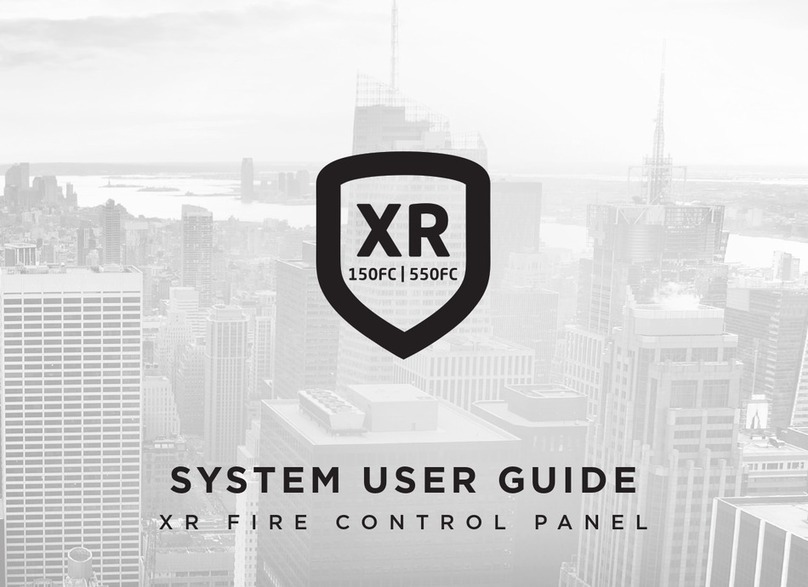
DMP Electronics
DMP Electronics XR150FC Series System user's guide
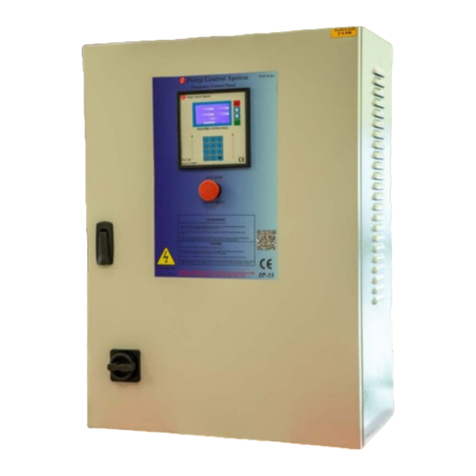
DUYAR
DUYAR FGE-01 Installation, maintenance and operation guide
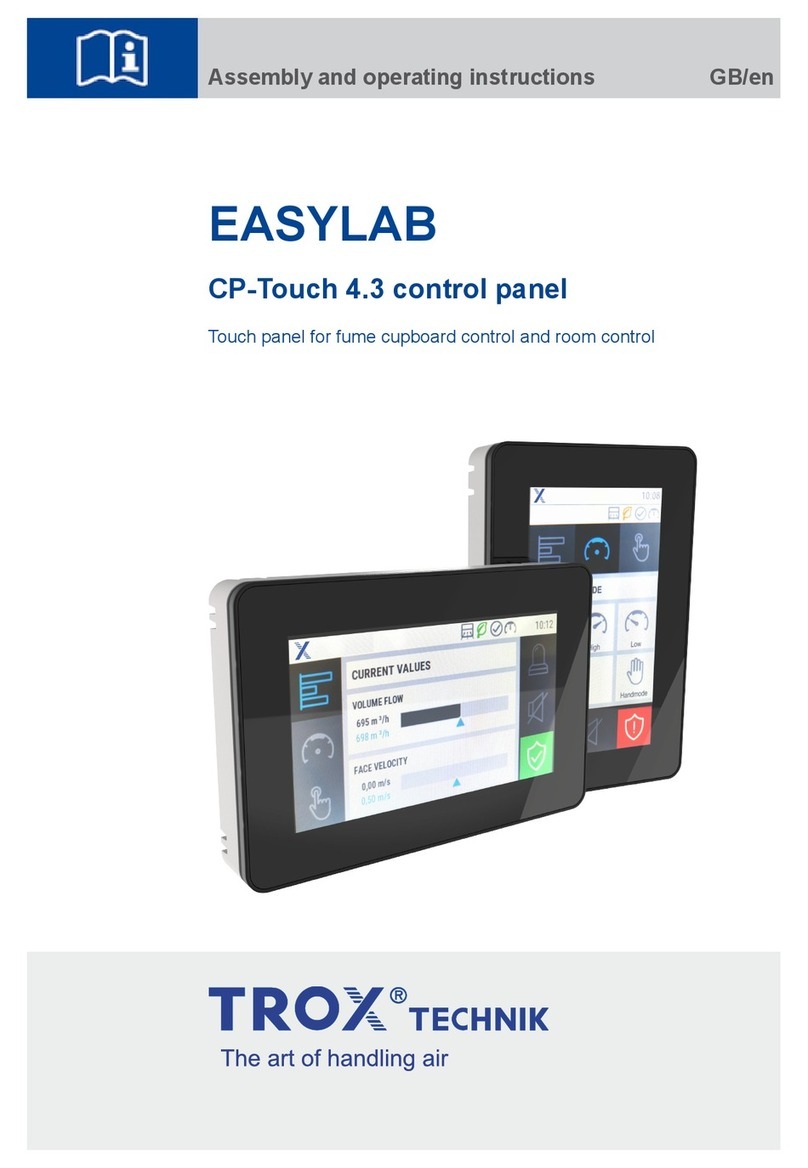
Trox Technik
Trox Technik EASYLAB Assembly and operating instructions

ESAB
ESAB Caddy A32 instruction manual
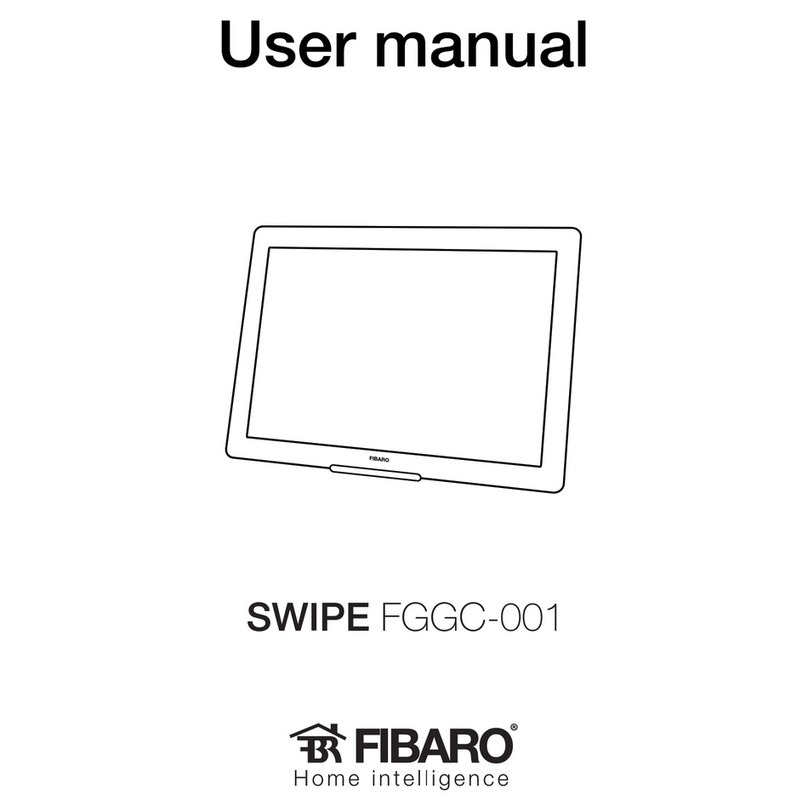
FIBARO
FIBARO SWIPE FGGC-001 user manual

Genesis
Genesis Integrated Security System user manual
